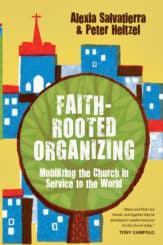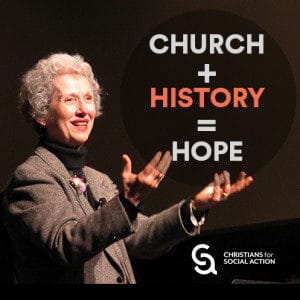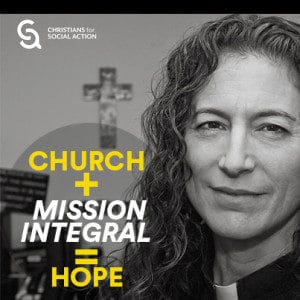
Working to change the broader community while also becoming a model community
Organizing is exhausting. The forces of injustice are often ruthless and so well-funded that they have replacements ready to go each time a foot soldier tires. In many countries (and in certain times and places in the US), organizers face the regular threat of violence. There are never enough resources or staff; organizers must, as the White Queen said in Alice in Wonderland, often do six impossible things before breakfast.
Organizing culture, particularly in the US, is often brutal in its constant demand to put the cause above all other aspects of life. This results in organizations that resemble the military in their reliance on young, relatively inexperienced recruits, who leave the field after a few years of work. While organizers may build relationships that go beyond work, the bottom line assumption is that they are together to do a job. Their value to the organization comes from their efforts and achievements.
Congregations are unique in the US movement for justice in that they maintain two simultaneous purposes—working to change the broader community while also becoming a model community. Congregations and other faith communities are focused not only on achieving an objective mission in the outside world but also on the personal growth of every individual and the task of caring for one another. These are understood as intrinsically worthy goals. People come to congregations to be healed from their wounds and sustained in their daily lives and work. While congregations often demand a high level of sacrifice, they are intentionally formed to be holistic communities.
Love. When the church is fulfilling its call, people in faith communities are regularly renewed by love. And when a faith community teaches the “theology from below,” its members are also inspired and equipped to be the body of Jesus Christ, broken in and for the world. Members are energized by the deep bond of love that unites Jesus and the church; they challenge one another, the larger religious institutions, and the whole society to live under God’s reign of love and justice. Congregational practices that encourage the rhythm of contemplation/action, sabbath rest, and committed discipleship also help to build healthy individuals and relationships. Practices such as repentance, honest confession, forgiveness, and reconciliation also help deepen and sustain healthy relationships over time.
Family. In addition, congregations are full of families rooted in faith traditions that view the family as the core building block of society. Congregations have historically devoted significant resources and activities to caring for and supporting families. Meanwhile, as Saul Alinsky writes, “the marriage record of organizers is with rare exception disastrous.” The children of successful organizers often have little connection with (and even some resentment for) their parents. Congregations that take their jobs seriously as nurturers of kingdom communities help families, including children, to participate on multiple levels in God’s work of justice, and make space for their needs.
Liturgies. When children are involved, organizing becomes more likely to respect and care for the child in each of us. Spiritual renewal often comes from shared lamentation and celebration; children need activities that are colorful and emotionally vibrant. It is no accident that ancient liturgies are packed with activities that appeal to all the senses and provoke a variety of emotions. Activities such as Seder meals ritually celebrating the liberation of Hebrew slaves from Egypt (in the Jewish community) or posadas (a Hispanic ritual in which processions reenact Mary and Joseph’s search for a place to give birth) awaken hearts and minds to a re-energizing and sustaining message.
Music. Recent studies tell us that music has measurable healing properties. As an ongoing part of congregational life, we see the power of music to provide healing and hope. Paul Gilroy argues in The Black Atlantic that music was integral to identity formation among the African diaspora because it could express the horror of the Middle Passage and slavery through primarily nonrepresentational forms. From the Underground Railroad for escaping slaves to the civil rights movement, music has fueled the struggle for justice. The spirituals and the blues were a deep river of strength amidst weakness, triumph amidst tragedy, and hope amidst despair.
Prayer. Prayer—the lifeblood of spiritual communities—nurtures and heals us while giving us real power to carry out our mission. Prayer is not a strategy; it is a way of life. However, believers agree that prayer has power, and it is no shame to use our power for God’s purposes. In fact, it is our calling to do so.

Most congregational prayers for leaders are perfunctory—a line or two in a worship service. In faith-rooted organizing, we have learned on the ground that prayer is as effective in the public arena as it is in the private arena. The San Diego Interfaith Committee for Worker Justice (ICWJ) was part of a broad coalition working to pass living-wage legislation. The coalition attended city council meetings every week and used the public commentary period to raise its concerns. As is common practice, the coalition carefully crafted talking points to ensure that the comments all communicated a common and clear message. But the San Diego ICWJ decided that they needed to participate in an alternative, faith-rooted way. So every one of their leaders that approached the podium used their time (one to three minutes) to pray. They prayed for the poor, for the community and for the city council. They prayed in whatever way they felt called to pray. When the legislation passed, a journalist asked a conservative council member why he had voted for the living wage. He responded that he could not take being prayed for one more week. He had armed himself against the talking points, but he had no armor against the prayer. The prayer reached his heart.
A few years later, a coalition of congregations named Amos in Cincinnati, Ohio (utilizing a hybrid of faith-rooted and more traditional organizing), was trying to pass legislation that would increase the availability of municipal jobs to ex-offenders. They were aware that this issue had major racial implications; African Americans in Cincinnati were more likely to go to prison for a crime in situations when others would be given less severe penalties. Amos assigned two to three congregations to pray fervently and regularly for each city council member. They let city council members know that they were being prayed for; in fact, they sometimes prayed with them and even over them. The struggle to pass the legislation had been long and hard, but when the extra element of prayer was added, the legislation passed.
Fasting. Jesus said that certain demons could only be expelled with prayer and fasting. Cesar Chavez utilized fasting and prayer for multiple purposes. According to Dolores Huerta, Cesar fasted when farmworkers were murdered while on strike. He encouraged the whole farmworker community to join him, trusting that fasting and prayer would help them to remain strong in their faith and resolve. He would fast regularly for three days or for seven days when important negotiations were coming up for the sake of clarity in hearing God’s voice. He was also known for his extended fasts, which helped preserve the nonviolent commitment of his movement and, in 1972, served to take the hatred out of the hearts of the growers in Arizona. Thanks in part to his extended fast there, a law was defeated that would have made it illegal for farmworkers to strike or boycott.
In 1999 Maria Elena Durazo, the deeply faithful president of Local 11 of the Hotel Employees and Restaurant Employees Union, was fighting to save the jobs of unionized food workers at the University of Southern California. She prayed and fasted for a month and was ultimately joined by hundreds of workers, students, and faculty. The university changed its policies, and the jobs were saved. I (Alexia) have been part of many campaigns since then where workers have fasted and prayed publicly for days, sleeping in encampments in front of their corporate employers, joined by clergy and congregational leaders. These extended fasts have served to strengthen the workers and build community support, even when they do not succeed in moving the hearts of the mighty.
Cesar never wanted to call a fast a hunger strike, because he never wanted it to be coercive; instead, he saw it as an offering to God. Fasting helps faith-rooted organizers surrender their souls to God while also inspiring the movement to press on in the struggle.
 Rev. Alexia Salvatierra is an ordained pastor in the Evangelical Lutheran Church in America. She also serves as a consultant for a variety of faith-based justice organizations and as adjunct faculty at the New York Theological Seminary and Biola University. Peter Heltzel is associate professor of theology and director of the Micah Institute at New York Theological Seminary. This article is taken from Faith-Rooted Organizing: Mobilizing the Church in Service to the World and is used by permission of InterVarsity Press.
Rev. Alexia Salvatierra is an ordained pastor in the Evangelical Lutheran Church in America. She also serves as a consultant for a variety of faith-based justice organizations and as adjunct faculty at the New York Theological Seminary and Biola University. Peter Heltzel is associate professor of theology and director of the Micah Institute at New York Theological Seminary. This article is taken from Faith-Rooted Organizing: Mobilizing the Church in Service to the World and is used by permission of InterVarsity Press.


